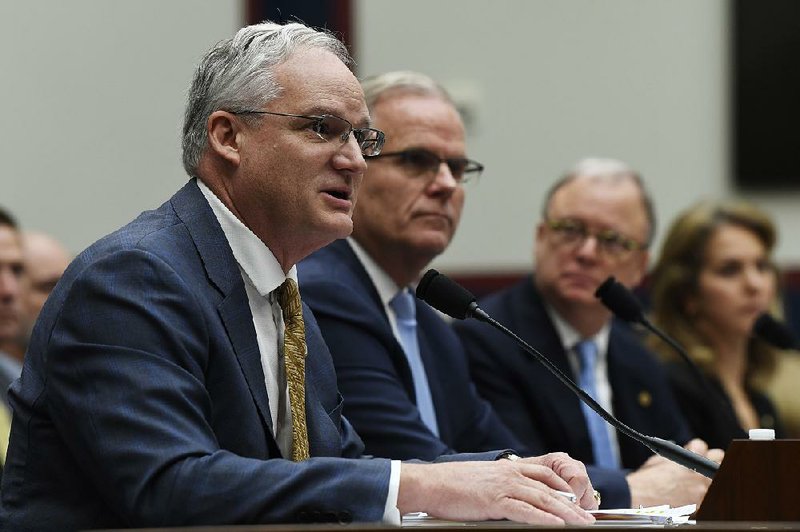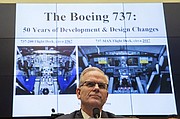The acting head of the Federal Aviation Administration defended the agency's certification procedures involving the now-grounded Boeing 737 Max airplane, telling the House Transportation Committee on Wednesday that the process by which company-paid employees inspected their own aircraft was "a good system."
The FAA executive, Daniel Elwell, said his agency was reviewing a decades-old practice that allowed FAA-certified employees at 79 aircraft manufacturers to assist in the certification of airplanes. But he said he supported the idea of delegating "certain tasks and certain decisions" in the certification process to private employees, despite criticism that the practice has led to lax oversight.
Elwell, a former pilot and industry lobbyist, faced two hours of questions from skeptical members of the committee at the first of several hearings the committee plans to hold about the regulator's role in the wake of two fatal crashes involving the troubled airliner.
"How can we have a single point of failure on a modern aircraft?" asked Rep. Peter DeFazio, D-Ore., the committee's chairman. DeFazio questioned whether the inspection system may have led to the problems with the airliner. "How was that certified? We shouldn't have to be here today."
Rep. Rick Larsen, D-Wash., heads the Transportation Committee's Subcommittee on Aviation. He pressed Elwell on the agency's designee authorization process, and the FAA's role in the development of pilot training procedures for the 737 Max. Pilots were not told about a new automated flight-control system that can push the nose of the plane down if a single sensor detects that the plane could be nearing an aerodynamic stall. That system, called MCAS, was triggered on both fatal flights by faulty sensor readings, and pilots were not able to regain control of the planes as they plunged to Earth.
"The committee's investigation is just getting started, and it will take some time to get answers, but one thing is clear right now: The FAA has a credibility problem," Larsen said.
The 737 Max was grounded in March after an Ethiopian Airlines flight crashed shortly after takeoff from Addis Ababa, killing all 157 people on board. Less than five months earlier, a Lion Air 737 Max flight went down in Indonesia, killing 189 people.
"I thought the MCAS should have been more adequately explained" to pilots around the world, Elwell said. He faced a number of questions about whether pilots were given proper training on changes to the plane's navigation and stabilization systems.
The agency, Elwell said, delegates to the employees of manufacturers only those aspects of aircraft inspection that do not pertain directly to an aircraft's core safety functions. But Elwell did acknowledge that the problems with the anti-stall system were, indeed, considered a critical safety issue -- raising new questions about whether Boeing employees should have been allowed to inspect it.
Elwell also said he was "not happy" with the 13-month lag between reports of a "software anomaly" involving a warning light that notifies pilots of a disagreement in sensors that measure which direction the plane is pointed, and Boeing's actions to address the problem. Boeing discovered in 2017 that the warning light worked only on planes with an optional indicator that displayed the sensor readings. That indicator was sold as an add-on, and only 20% of 737 Max customers purchased it. Neither the Lion Air not the Ethiopian Airlines plane had it.
Still, Elwell said he did not believe that problem contributed to either crash.
Boeing is expected to soon submit a software fix that would keep the automated system from activating based on erroneous data, a factor in both crashes, according to agency investigators. An early version of the new software is being tested in simulators, FAA officials said.
Elwell gave no timetable for when the plane might be cleared to fly again. He said the agency would only clear the planes on the recommendation of a multiagency technical advisory board made up of experts from the FAA, the Air Force, NASA and the Volpe National Transportation Systems Center who were not involved in the initial certification of the 737 Max.
Over the past two months, DeFazio has requested a trove of documents from the FAA and Boeing regarding the inspection process and the review undertaken to determine the safety of the anti-stall system. He is especially focused on why Boeing did not require pilots to undergo further training with the system.
DeFazio has received none of the requested documents yet, although the FAA is expected to begin releasing documents to the committee soon. DeFazio warned the manufacturer that it needed to supply the documents "voluntarily" or he would seek other means to the obtain them.
Information for this article was contributed by David Koenig, Marcy Gordon and Tom Krisher of The Associated Press.
A Section on 05/16/2019

